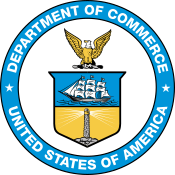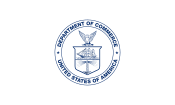United States Department of Commerce
 Seal of the U.S. Department of Commerce | |
 Flag of the U.S. Department of Commerce | |
 The Herbert C. Hoover Building, the headquarters of the U.S. Department of Commerce. | |
| Agency overview | |
|---|---|
| Formed | February 14, 1903 (1903-02-14) |
| Headquarters | Herbert C. Hoover Building 1401 Constitution Avenue NW, Washington, D.C., U.S. 38°53′39.48″N 77°0′58.08″W / 38.8943000°N 77.0161333°W / 38.8943000; -77.0161333Coordinates: 38°53′39.48″N 77°0′58.08″W / 38.8943000°N 77.0161333°W / 38.8943000; -77.0161333 |
| Employees | 43,880 (2011)[1] |
| Annual budget | US$10.2 billion (2009) US$14.2 billion (est. 2010) US$9.3 billion (est. 2011) US$8.6 billion (2014)[2] |
| Agency executives |
|
| Website | www.commerce.gov |
| Footnotes | |
The United States Department of Commerce is the Cabinet department of the United States government concerned with promoting economic growth. Among its tasks are gathering economic and demographic data for business and government decision-making, and helping to set industrial standards. This organization's main purpose is to create jobs, promote economic growth, encourage sustainable development and improve standards of living for all Americans.[3] The Department of Commerce headquarters is the Herbert C. Hoover Building in Washington, D.C.
Wilbur Ross is the current Commerce secretary.
Contents
1 History
2 Organization
2.1 Structure
2.2 Budget and finances
3 Reorganization proposals
4 See also
5 References
6 External links
History
The department was originally created as the United States Department of Commerce and Labor on February 14, 1903. It was subsequently renamed the Department of Commerce on March 4, 1913, as the bureaus and agencies specializing in labor were transferred to the new Department of Labor. The United States Patent and Trademark Office was transferred from the Interior Department into Commerce, and the Federal Employment Stabilization Office existed within the department from 1931 to 1939. In 1940, the Weather Bureau (now the National Weather Service) was transferred from the Agriculture Department, and the Civil Aeronautics Authority was merged into the department. In 1949, the Public Roads Administration was added to the department due to the dissolution of the Federal Works Agency. In 1958, the independent Federal Aviation Agency was created and the Civil Aeronautics Authority was abolished. The United States Travel Service was established by the United States Secretary of Commerce on July 1, 1961 pursuant to the International Travel Act of 1961 (75 Stat. 129; 22 U.S.C. 2121 note)[4] The Economic Development Administration was created in 1965. In 1966, the Bureau of Public Roads was transferred to the newly created Department of Transportation. The Minority Business Development Agency (MBDA) was created on March 5, 1969, originally established by President Richard M. Nixon as the Office of Minority Business Enterprise.
The National Oceanic and Atmospheric Administration (NOAA) was created on October 3, 1970.[5]
Organization
Structure
| Program | |
|---|---|
Secretary of Commerce | Deputy Secretary of Commerce |
| Office of Public Affairs | |
| Office of Business Liaison | |
| Office of Executive Secretariat | |
| Office of White House Liaison | |
| Office of Policy and Strategic Planning | |
| Office of the General Counsel | |
| Office of Inspector General | |
| Office of the Chief Financial Officer and Assistant Secretary for Administration | |
| Office of Legislative and Intergovernmental Affairs | |
| Office of the Chief Information Officer | |
Economic Development Administration | |
Minority Business Development Agency | |
National Telecommunications and Information Administration | |
National Institute of Standards and Technology | |
National Technical Information Service | |
Under Secretary of Commerce for Economic Affairs | Office of the Chief Economist |
Economics and Statistics Administration | |
Bureau of Economic Analysis | |
Bureau of the Census | |
Under Secretary of Commerce for International Trade | International Trade Administration |
United States Commercial Service | |
Under Secretary of Commerce for Industry and Security | Bureau of Industry and Security |
Office of Security | |
Under Secretary of Commerce for Oceans and Atmosphere | National Oceanic and Atmospheric Administration |
National Marine Fisheries Service | |
National Weather Service | |
National Ocean Service | |
Office of Oceanic and Atmospheric Research | |
| Office of Marine and Aviation Operations | |
National Oceanic and Atmospheric Administration Commissioned Corps | |
Under Secretary of Commerce for Intellectual Property | Patent and Trademark Office |
Budget and finances
The Department of Commerce was authorized a budget for Fiscal Year 2015 of $14.6 billion. The budget authorization is broken down as follows:[6]
| Program | Funding (in millions) |
|---|---|
Management and Finance | |
| Departmental Management | $73.2 |
| Office of the Inspector General | $35.5 |
Operating Divisions | |
| Economic Development Administration | $248.1 |
| Census Bureau | $1,240.0 |
| Bureau of Economic Analysis | $111.0 |
| International Trade and Investment Administration | $497.3 |
| Bureau of Industry and Security | $110.5 |
| Minority Business Development Agency | $28.3 |
| National Oceanic and Atmospheric Administration | $5,684.7 |
| Patent and Trademark Office | $3,439.5 |
| National Institute of Standards and Technology | $904.9 |
| National Telecommunications and Information Administration | $51 |
Mandatory Spending | |
| Public Safety Broadband Network | $2,275 |
TOTAL | $14,565 |
Reorganization proposals
Proposals to reorganize the Department go back many decades.[3] The Department of Commerce was one of three departments that Texas governor Rick Perry advocated eliminating during his 2012 presidential campaign, along with the Department of Education and Department of Energy. Perry's campaign cited the frequency with which agencies had historically been moved into and out of the department and its lack of a coherent focus, and advocated moving its vital programs into other departments such as the Department of the Interior, Department of Labor, and Department of the Treasury. The Economic Development Administration would be completely eliminated.[7]
On January 13, 2012, President Obama announced his intentions to ask the United States Congress for the power to close the department and replace it with a new cabinet-level agency focused on trade and exports. The new agency would include the Office of the United States Trade Representative, currently part of the Executive Office of the President, as well as the Export-Import Bank of the United States, the Overseas Private Investment Corporation, the United States Trade and Development Agency, and the Small Business Administration, which are all currently independent agencies. The Obama administration projected that the reorganization would save $3 billion and would help the administration's goal of doubling U.S. exports in five years.[8] The new agency would be organized around four "pillars": a technology and innovation office including the United States Patent and Trademark Office and the National Institute of Standards and Technology; a statistical division including the United States Census Bureau and other data-collection agencies currently in the Commerce Department, and also the Bureau of Labor Statistics which would be transferred from the Department of Labor; a trade and investment policy office; and a small business development office. The National Oceanic and Atmospheric Administration (NOAA) would be transferred from the Department of Commerce into the Department of the Interior.[9] Later that year, shortly before the 2012 presidential election, Obama invoked the idea of a "secretary of business" in reference to the plan.[10] The reorganization was part of a larger proposal which would grant the President the authority to propose mergers of federal agencies, which would then be subject to an up-or-down Congressional vote. This ability had existed from the Great Depression until the Reagan presidency, when Congress rescinded the authority.[11]
The Obama administration plan faced criticism for some of its elements. Some Congress members expressed concern that the Office of the United States Trade Representative would lose focus if it were included in a larger bureaucracy, especially given its status as an "honest broker" between other agencies, which tend to advocate for specific points of view.[8][12] The overall plan has also been criticized as an attempt to create an agency similar to Japan's powerful Ministry of International Trade and Industry, which was abolished in 2001 after some of its initiatives failed and it became seen as a hindrance to growth.[12] NOAA's climate and terrestrial operations and fisheries and endangered species programs would be expected to integrate well with agencies already in the Interior Department, such as the United States Geological Survey and the United States Fish and Wildlife Service. However, environmental groups such as the Natural Resources Defense Council feared that the reorganization could distract the agency from its mission of protecting the nation's oceans and ecosystems.[13] The plan was reiterated in the Obama administration's FY2016 budget proposal that was released in February 2015.[14]
See also
- Title 13 of the Code of Federal Regulations
- Title 15 of the Code of Federal Regulations
- Title 19 of the Code of Federal Regulations
- Commerce Department trade mission controversy
- USAFacts
- USA.gov
- Bureau of Industry and Security
References
^ "Department of Commerce FY 2011 Budget in Brief". United States Department of Commerce Office of Budget..mw-parser-output cite.citation{font-style:inherit}.mw-parser-output q{quotes:"""""""'""'"}.mw-parser-output code.cs1-code{color:inherit;background:inherit;border:inherit;padding:inherit}.mw-parser-output .cs1-lock-free a{background:url("//upload.wikimedia.org/wikipedia/commons/thumb/6/65/Lock-green.svg/9px-Lock-green.svg.png")no-repeat;background-position:right .1em center}.mw-parser-output .cs1-lock-limited a,.mw-parser-output .cs1-lock-registration a{background:url("//upload.wikimedia.org/wikipedia/commons/thumb/d/d6/Lock-gray-alt-2.svg/9px-Lock-gray-alt-2.svg.png")no-repeat;background-position:right .1em center}.mw-parser-output .cs1-lock-subscription a{background:url("//upload.wikimedia.org/wikipedia/commons/thumb/a/aa/Lock-red-alt-2.svg/9px-Lock-red-alt-2.svg.png")no-repeat;background-position:right .1em center}.mw-parser-output .cs1-subscription,.mw-parser-output .cs1-registration{color:#555}.mw-parser-output .cs1-subscription span,.mw-parser-output .cs1-registration span{border-bottom:1px dotted;cursor:help}.mw-parser-output .cs1-hidden-error{display:none;font-size:100%}.mw-parser-output .cs1-visible-error{font-size:100%}.mw-parser-output .cs1-subscription,.mw-parser-output .cs1-registration,.mw-parser-output .cs1-format{font-size:95%}.mw-parser-output .cs1-kern-left,.mw-parser-output .cs1-kern-wl-left{padding-left:0.2em}.mw-parser-output .cs1-kern-right,.mw-parser-output .cs1-kern-wl-right{padding-right:0.2em}
^ "Department Of Commerce – FY 2014 Budget" (PDF). www.tamuc.edu. Archived from the original (PDF) on 2013-08-08. Retrieved October 15, 2017.
^ ab Steve Charnovitz, "Reinventing the Commerce Dept.," Journal of Commerce, July 12, 1995.
^ "United States Travel and Tourism Administration (1961-1996)". Department of Commerce Digitization Repository Project. Pennsylvania State University. Retrieved November 20, 2014.
^ "Milestones". United States Department of Commerce. July 20, 2010. Retrieved January 19, 2012.
^ 2015 Department of Commerce Budget-in-Brief, United States Department of Commerce, Accessed July 16, 2015
^ "Uproot and Overhaul Washington: Eliminate and Restructure Wasteful Federal Agencies". RickPerry.org, Inc. Retrieved January 19, 2012.
^ ab MacInnis, Laura (January 13, 2012). "Obama wants export agency, closing of Commerce Department". Reuters. Retrieved January 19, 2012.
^ Mervis, Jeffrey (January 13, 2012). "What Would Wiping Out the Commerce Department Mean for Science?". ScienceInsider. American Association for the Advancement of Science. Retrieved January 19, 2012.
^ Schroeder, Peter (October 29, 2012). "Obama floats plan for a 'secretary of Business' if he wins second term". The Hill. Retrieved May 23, 2014.
^ Landler, Mark; Lowrey, Annie (January 14, 2012). "Obama Bid to Cut the Government Tests Congress". The New York Times. p. A1. Retrieved January 19, 2012.
^ ab Bartlett, Bruce (January 17, 2012). "The Pros and Cons of Obama's Reorganization Plan". The New York Times. Economix. Retrieved January 19, 2012.
^ Malakoff, David (January 13, 2012). "Rough Sailing for Plan to Move NOAA?". ScienceInsider. American Association for the Advancement of Science. Retrieved January 19, 2012.
^ Hicks, Josh (February 3, 2015). "Six ways the White House budget would affect federal workers". The Washington Post. Retrieved February 3, 2015.
External links
| Wikimedia Commons has media related to United States Department of Commerce. |
Wikisource has the text of a 1922 Encyclopædia Britannica article about Department of Commerce. |
Official website
Department of Commerce in the Federal Register
- US Commercial Service
- Department of Commerce Representation in the UK
